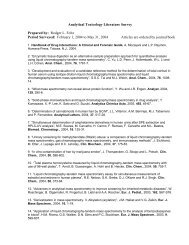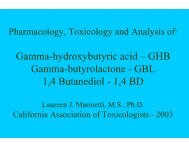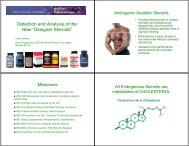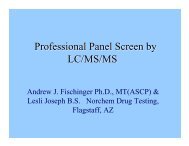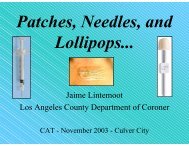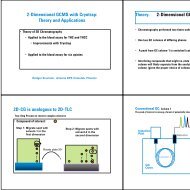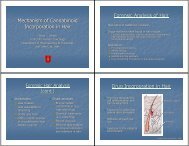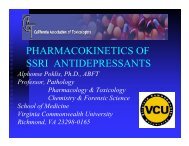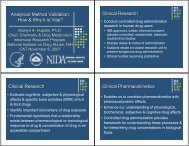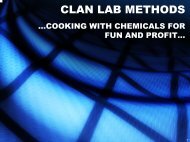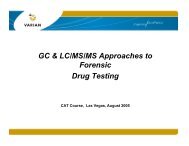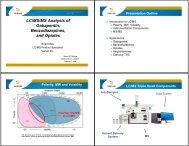Two Pediatric Methadone Fatalities: Case Reports from the Office of ...
Two Pediatric Methadone Fatalities: Case Reports from the Office of ...
Two Pediatric Methadone Fatalities: Case Reports from the Office of ...
Create successful ePaper yourself
Turn your PDF publications into a flip-book with our unique Google optimized e-Paper software.
<strong>Two</strong> <strong>Pediatric</strong> <strong>Methadone</strong><br />
<strong>Fatalities</strong>: <strong>Case</strong> <strong>Reports</strong><br />
<strong>from</strong> <strong>the</strong> <strong>Office</strong> <strong>of</strong> <strong>the</strong> Medical<br />
Examiner<br />
Phoenix, Arizona<br />
Kim McCall Tackett, BS; Amy Lais, BS;<br />
Diane Mertens Maxham, BS; Vladimir<br />
Shvarts, MD; and Norman A. Wade, MS<br />
<strong>Methadone</strong><br />
• Syn<strong>the</strong>tic Opioid<br />
• Syn<strong>the</strong>sized during WW II by<br />
German Scientists (morphine 1803)<br />
• Clinically available in US in 1947<br />
• Used for treatment <strong>of</strong> narcotic<br />
addictions (early 1970’s)<br />
• Later used for treatment <strong>of</strong> chronic<br />
pain
<strong>Methadone</strong><br />
• Prior use and cellular tolerance<br />
significant when evaluating blood<br />
concentrations<br />
• Fatal concentrations vary greatly<br />
• Overlapping <strong>the</strong>rapeutic and lethal<br />
ranges<br />
• Little information about incidence and<br />
associated toxicity in pediatrics<br />
<strong>Methadone</strong> Emphasis<br />
• Comparison with morphine: Much longer<br />
duration <strong>of</strong> action<br />
• Stereochemistry: Used as a racemic mixture<br />
• Variability: In both pharmacokinetics and<br />
pharmacodynamics<br />
• Adverse effects: Respiratory depression and<br />
ventricular arrhythmias (?)<br />
• Caution: In initiation or alteration <strong>of</strong> <strong>the</strong>rapy<br />
Structure <strong>of</strong> <strong>Methadone</strong><br />
Pharmacokinetics A<br />
• Oral Availability: 92%<br />
• Plasma protein binding: 89%<br />
• Clearance: 2.3 mL/min/kg<br />
• Volume <strong>of</strong> distribution: 3.6 L/kg<br />
• Elimination half-life: 27 (15-40 hr) (5-130<br />
hr): similar for <strong>the</strong> stereoisomers<br />
• Peak effect ~ 1 hr sc or im; 4 hr po<br />
• Dosing interval after first dose may be<br />
shorter due to redistribution than after<br />
chronic (accumulation)
Pharmacokinetics B<br />
• Urinary excretion about 24%, (10-35%)<br />
and depends on pH because <strong>of</strong> ion<br />
trapping in acid urine<br />
• Up to 90% can be eliminated by hepatic<br />
biotransformation<br />
– P450 N-demethylation followed by cyclization<br />
to pyrrolidines and pyrroline<br />
– O<strong>the</strong>r metabolites<br />
– CYP3A4, CYP2C8 and CYP2D6 all participate<br />
in <strong>the</strong> stereoselective oxidative metabolism<br />
Drug Interactions<br />
• Barbiturates, carbamazepine, efavirenz (NNRTI),<br />
nevirapine (induction <strong>of</strong> CYP3A4), phenytoin and<br />
rifampin accelerate metabolism <strong>of</strong> methadone<br />
and can precipitate withdrawal symptoms<br />
• Fluvoxamine (SSRI) decreases metabolism <strong>of</strong><br />
methadone and can lead to methadone toxicity<br />
• Potential methadone toxicity:<br />
– Ketoconazole (CYP3A4 selective inhibitor)<br />
– Trimethoprim (CYP2C8 selective inhibitor)<br />
– Paroxetine (CYP2D6, CYP3A4, CYP2C8 inhibitor)<br />
Accumulation<br />
• With repeated doses steady-state plasma<br />
drug concentrations are reached in about<br />
4 times <strong>the</strong> elimination half-life<br />
• For methadone that usually takes 60-160<br />
hours (3-7 days); also same for excretion<br />
• Impaired metabolism by liver disease,<br />
inhibition <strong>of</strong> CYP enzymes, and/or<br />
genetically slower metabolism may give<br />
accumulation time <strong>of</strong> 520 hours (22 days)
Pharmacodynamics<br />
• Stereoisomers: d(S) and l(R) racemic mixture<br />
• The analgesic activity <strong>of</strong> <strong>the</strong> racemic mixture is<br />
almost entirely <strong>the</strong> result <strong>of</strong> <strong>the</strong> content <strong>of</strong> levo -<br />
methadone, which is 8-50 times more potent<br />
than <strong>the</strong> d-isomer<br />
• D-methadone also lacks significant respiratory<br />
depressant action and addiction liability but does<br />
have possess antitussive activity<br />
Mu Opioid Receptor<br />
• <strong>Methadone</strong> (l) is an agonist at this receptor<br />
• G protein linked<br />
• Located in <strong>the</strong> respiratory control areas <strong>of</strong><br />
pons (rate <strong>of</strong> respiration) and medulla<br />
(rhythm, drive/force, integration,<br />
chemoreception) <strong>of</strong> <strong>the</strong> brain<br />
• Activated by exogenous/endogenous<br />
opioids<br />
• Blocked by Naloxone<br />
Respiratory Depression<br />
• Potassium Channel<br />
– Opioids increase conductance by increasing <strong>the</strong> flow<br />
<strong>of</strong> K ions which hyperpolarizes neurons so <strong>the</strong>y will<br />
not fire<br />
• Adenyl Cyclase<br />
– Inhibition by opioids decreases cAMP<br />
• Chloride Channel<br />
– Opioids have no effect here but o<strong>the</strong>rs do<br />
e.g. Benzodiazepines, Prop<strong>of</strong>ol and Phenobarbital<br />
increase conductance<br />
Increase in <strong>Methadone</strong> Rxs<br />
• Change in Rx pattern for chronic pain<br />
• Less rigid regulatory environment for<br />
providers<br />
• Changing knowledge basis<br />
– Physiology <strong>of</strong> pain<br />
– Molecular biology <strong>of</strong> nociception<br />
– Applied pharmacology in pain Rx<br />
– Cost and <strong>the</strong> 3 rd party payers !!!!
<strong>Methadone</strong> Death Investigations<br />
• Decedent Hx – Rx and illicit drug<br />
abuse<br />
• Signs/Symptoms – euphoria, slurred<br />
speech, ataxia,unable to arouse,<br />
snoring, coma, death<br />
• Pathology – pulmonary and cerebral<br />
edema<br />
• Scene Markers – drug paraphernalia;<br />
Rxs<br />
Interacting Factors<br />
• Pharmacologic<br />
– Low or lost opioid tolerance<br />
– Slower or altered opioid metabolism<br />
– Drug interactions (e.g. benzodiazepines)<br />
– Time <strong>of</strong> death in relation to ingestion<br />
• Postmortem<br />
– Acute, rapid death vs. delayed death<br />
– Postmortem redistribution<br />
Mechanism <strong>of</strong> Death<br />
• <strong>Methadone</strong> produces hypoventilation,<br />
sleep-disordered breathing and sleep<br />
apnea…even in stable MMT patients<br />
• Effect <strong>of</strong> benzodiazepines were not related<br />
to postmortem concentrations…low levels<br />
result in relaxation <strong>of</strong> respiratory<br />
muscles…potentially leading to obstruction<br />
• Occlusion <strong>of</strong> airway is more likely in slow<br />
developing cumulative toxicity <strong>of</strong> <strong>the</strong> drug
Why People Die…<br />
Suicide by a 12 Year Old<br />
• Moderate to high doses <strong>of</strong> drug not<br />
tolerated well in opioids naïve patients<br />
• Prior experience with opioids (tolerance)<br />
cannot protect one <strong>from</strong> <strong>the</strong> adverse<br />
effects <strong>of</strong> methadone (CNS depression)<br />
• Co-ingestion <strong>of</strong> ethanol and o<strong>the</strong>r CNS<br />
depressant drugs leads to synergism<br />
• O<strong>the</strong>r factors include long half-life, etc.<br />
<strong>Case</strong> # 1<br />
• 12 y.o. female found unresponsive in<br />
bedroom by family<br />
• Suicide history; self mutilations<br />
• EMS summoned<br />
• Resuscitation efforts unsuccessful<br />
• Death pronounced at scene<br />
• Frothy purge noted <strong>from</strong> mouth<br />
Autopsy<br />
• Performed 55 hours after death<br />
• 120 lb./ 65 inches - Caucasian Female<br />
• Lungs congested: Left 500g, Right 510g<br />
• Cerebral edema: Brain 1350g<br />
• Heart wt: 250g<br />
• Liver: 1000g<br />
• Spleen: 200g Kidneys: 120 g<br />
• Gastric: 150 mL brown semisolid fluid
Specimens Collected<br />
• Pleural Fluid<br />
• Bile<br />
• Vitreous Fluid<br />
• Gastric Contents<br />
• Liver<br />
• Spleen<br />
• Brain<br />
Analytical Protocol<br />
• Volatile screen on vitreous and pleural fluid<br />
by GC-FID –Positive ethanol<br />
• ELISA screen on pleural fluid –Negative<br />
• Qualitative analysis for basic drugs on<br />
pleural fluid and bile – Positive <strong>Methadone</strong><br />
• Analyzed by GC-NPD and GC/MS<br />
• Only <strong>Methadone</strong> and low ethanol found<br />
• Quantitated by GC-NPD / 5 point calibration<br />
Levels in <strong>Pediatric</strong> Suicide<br />
Murder? <strong>of</strong> a Five Year Old<br />
• Pleural fluid 0.7 mg/L<br />
– Ethanol 0.07 g%<br />
• Brain - 1.15 mg/kg<br />
• Spleen - 3.43 g/kg<br />
• Liver - 5.98 mg/kg<br />
• Gastric- 111.27 mg/kg<br />
• 16.7 mg total
<strong>Case</strong> #2<br />
• Five year old male Caucasian child<br />
• 43 inches tall, 44 pounds = “normal”<br />
• Treated for Autism (??)<br />
• Rx for Risperdal<br />
• Living alone with fa<strong>the</strong>r (mo<strong>the</strong>r deceased)<br />
• Hx <strong>of</strong> fever and congestion & ear infection<br />
• Apparently snoring / raspy breathing<br />
Specimens Collected<br />
• Cardiac Blood<br />
• Bile<br />
• Gastric<br />
• Urine<br />
• Vitreous<br />
• CSF<br />
• Lung Tissue<br />
• Culture Swabs<br />
Autopsy Findings<br />
• Externally no injuries or trauma<br />
• Heart 108 gm and normal<br />
• Lungs 164 / 212 gm & well expanded<br />
• Spleen/thymus/ lymphatic all normal<br />
• GI all normal with 75 mL brown/red<br />
PDF<br />
• 729 gm liver and pancreas normal<br />
• Kidneys 63 / 46 gm –grossly normal<br />
• Brain 1650 gm – no<br />
hemorrhages/fractures<br />
Levels in <strong>Pediatric</strong> Homocide<br />
• Cardiac blood<br />
• <strong>Methadone</strong> 0.34 mg/L<br />
• EDDP metabolite<br />
• Dextromethorphan 0.24 mg/L<br />
• Doxylamine 0.36 mg/L<br />
• Acetaminophen 69 mg/L<br />
• Risperidone < 0.005 mg/L<br />
• 9-Hydroxyrisperidone 0.006 mg/L
Levels in Five Year Old<br />
• Bile<br />
• Gastric<br />
• <strong>Methadone</strong> 0.63 mg/L<br />
• <strong>Methadone</strong> 23.8 mg/L (1.8 mg total)<br />
• EDDP metabolite<br />
• Dextromethorphan<br />
• Doxylamine<br />
Levels Continued<br />
• Urine<br />
• <strong>Methadone</strong> 8.36 mg/L<br />
• EDDP metabolite<br />
• EMDP metabolite<br />
• Dextromethorphan<br />
• Doxylamine<br />
• Doxylamine metabolite<br />
• Borate 7 mg/L – by NMS<br />
<strong>Methadone</strong> Lethal Levels<br />
• Segal/Ca<strong>the</strong>rman (1974)<br />
• Robinson & William (1971)<br />
• Manning et al. (1976)<br />
• Garriott/Sterner (1973)<br />
• Drummer (1992)<br />
• Clark et al. (1995)<br />
• Li et al.<br />
• Karch 2000 (2000)<br />
0 - 0.5 mg/L<br />
0.22 – 3.04 mg/L<br />
1.3 – 5.8 mg/L<br />
0.08 – 1.4 mg/L<br />
0.27 – 2.5 mg/L<br />
0.20 – 1.86 mg/L<br />
0.30 – 0.60 mg/L<br />
0.27 – 2.5 mg/L<br />
• Ther. Drug Monitoring, Vol 24, No. 4, 2002 - K. Woolf<br />
Phoenix OME Hx Levels<br />
Phoenix OME Hx Levels<br />
• Lowest Levels in Blood<br />
– Average 0.04 – 0.08 mg/L<br />
• Highest Levels in Blood<br />
– Range 2.3 – 7.0 mg/L (mean 3.0<br />
mg/L)<br />
– “<strong>Methadone</strong> is a lipophilic organic<br />
base known to concentrate to a<br />
considerable extent in solid organs,<br />
thus providing a gradient for passive<br />
diffusion after death.<br />
– This uneven distribution <strong>of</strong><br />
methadone might account for some<br />
but not all <strong>of</strong> <strong>the</strong> differences in blood<br />
concentrations reported at autopsy”<br />
• Karch
Conclusions<br />
• Cause <strong>of</strong> death<br />
– Drug overdose for both cases<br />
• Manner <strong>of</strong> death<br />
– Suicide (12 y/o); Undetermined (5<br />
y/o) Homocide or Accident by fa<strong>the</strong>r<br />
• Levels found versus historical data<br />
indicate a clear finding <strong>of</strong> lethal<br />
levels<br />
– 0.70 mg/L and 0.36 mg/L in blood<br />
References<br />
• SOFT <strong>Methadone</strong> Workshop 2003<br />
• G. D. Olsen, M.D.<br />
• Bruce A. Goldberger, Ph.D.<br />
• David Moody, Ph.D.<br />
• Kim Woolf, Ph.D.<br />
• Randall Baselt, Ph.D. “ Red Book “



